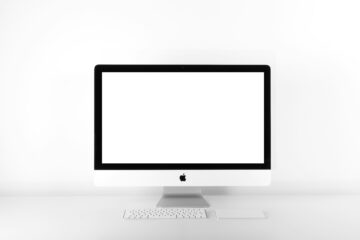
A person’s workflow is unique and personalized, like how people go about eating an ice cream cone. Nobody does it the same way, but we can get the job done.
Macs have many features that enable you to toggle between tasks including a multiple desktop solution or the three-finger swipe to open up mission control. But some people love having one or more monitors connected to their laptop or desktop so there’s not so much back and forth.
A questions we often get asked is if Macs can connect to multiple monitors. The simple answer is Yes. The more complicated answer is that it depends on the age and model of your Mac as to exactly how you connect to multiple monitors (and which monitors will work).
The Real Answer: This is Why Docking Stations Exist
The reality is you can’t just use any old monitor with any Mac, there are a bunch of scenarios where the answer is different based on the model of Mac you have.
In a nutshell, it’s about making sure your Mac is up to the task of running multiple monitors, and, if so, what types of displays it can accommodate. Then you need the respective connecting cables, dock, or adaptors to make it all happen.
If you have a newer Mac with the Thunderbolt 3/USB-C drive.
1. Identify the type of display (Traditional, USB-C, 4k, 5k, etc.). This will determine how many monitors your Macbook will be able to handle, as well as the type of adapter you’ll need to connect them.
2. Connect a tethered docking station to your Thunderbolt 3 port. A docking station like this one could do the trick. The dock essentially converts your single Thunderbolt 3 port into a variety of connection options.
3. Find the right connecting cables to connect from the docking station to your monitors. You’ll have options from the docking station and many solutions could work. The easiest is an HDMI cable with a USB-C/Thunderbolt 3 connection on one end (AKA HDMI to USB-C cable).
4. Connect your monitors to the docking station with the correct cables.
5. Once you’re connected you can change your display options by Choosing the Apple Menu > System Preferences, then click Displays.
6. Click the Arrangements tab. Make sure that the Mirror Displays checkbox isn’t selected.
7. Arrange your displays to match your desired setup by dragging the position of the display to the desired position. A red border appears around the display as it’s moved.
If you have an older Mac (ie pre-Thunderbold 3/USB-C drive):
1. Check the technical specifications on your Mac. To do this, click the Apple menu (top left corner), Select “About This Mac,” not your Macbook version and year, processor, memory and graphics.
2. Visit Apple’s website and search for your exact model. Then you can select “Support” to see what kind of monitor display your Mac can accommodate.
3. Get the right adapters and dongles. This is where knowing your Mac comes in handy. You need to know what types of ports your Mac has and what kind of connection your monitors will require. For instance, you may find that your Mac has an old Thunderbolt port and you will need a docking station that connects to this and then cables that connect from the docking station to the monitors.
4. Follow steps 5-7 above to properly display your monitors.
This more complicated than most how-to’s because there are so many different answers, so we understand if you have questions. We’re always here to support you.


